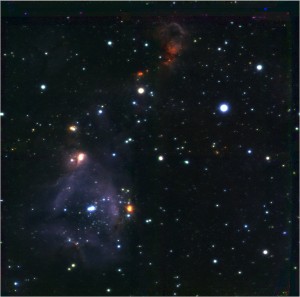- Date: 11 Dec 2014
- Comments: (0)
- Categories: For Everyone

An image of the the very young star form region N159W recently obtained with GeMS. Credit: Anais Bernard (Laboratoire d’Astrophysique de Marseille, LAM), Benoit Neichel (LAM).
Successful Multi-conjugate Adaptive Optics Run at Gemini South
The Gemini Multi-conjugate adaptive optics System (GeMS) at Gemini South has completed a successful run of 9 nights, with several programs executed and two completed. According to the AO science fellow Vincent Garrel the performance of the system was, “among the best performances we’ve ever achieved.”
Rodrigo Carrasco, associate astronomer at Gemini, reports that “During the nights of my shift, we obtained data with 70-80 milliarcsecond (mas) resolution. This is really good!”
Classical (visiting) observers, Sarah Sweet (from the Australian National University) and Benoit Neichel also report obtaining a significant amount of data, with resolutions between 70 to 100 mas (see image with this post).
Next Challenges…
The GeMS team is now actively preparing for the next big hardware upgrade called the Natural Guide Star New Generation Sensor (NGS2) program, which is been building by the Australian National University. Watch for updates here and on the Gemini website.
Also, a faulty detector, which is on one of the tip&tilt wavefront sensors, will be replaced – this has produced regular time loss. This repair should be ready for operations by the next GeMS run in January 2015.
Watch for more details in early 2015 on continued progress with Gemini’s powerful adaptive optics capabilities.





